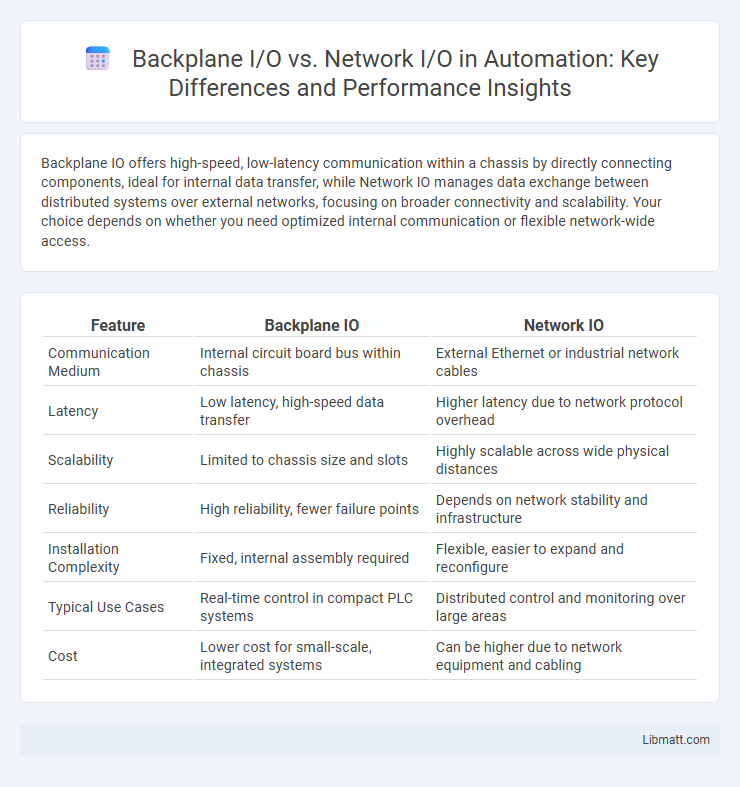Backplane IO offers high-speed, low-latency communication within a chassis by directly connecting components, ideal for internal data transfer, while Network IO manages data exchange between distributed systems over external networks, focusing on broader connectivity and scalability. Your choice depends on whether you need optimized internal communication or flexible network-wide access.
Table of Comparison
| Feature | Backplane IO | Network IO |
|---|---|---|
| Communication Medium | Internal circuit board bus within chassis | External Ethernet or industrial network cables |
| Latency | Low latency, high-speed data transfer | Higher latency due to network protocol overhead |
| Scalability | Limited to chassis size and slots | Highly scalable across wide physical distances |
| Reliability | High reliability, fewer failure points | Depends on network stability and infrastructure |
| Installation Complexity | Fixed, internal assembly required | Flexible, easier to expand and reconfigure |
| Typical Use Cases | Real-time control in compact PLC systems | Distributed control and monitoring over large areas |
| Cost | Lower cost for small-scale, integrated systems | Can be higher due to network equipment and cabling |
Introduction to Backplane IO and Network IO
Backplane IO refers to the internal communication channels within a hardware chassis, connecting modules and enabling high-speed data transfer among system components. Network IO involves data exchange between devices over external networks, such as Ethernet or fiber optics, supporting connectivity beyond a single enclosure. Understanding Backplane IO helps optimize internal system performance while Network IO is critical for managing external communications and data flow across distributed systems.
Core Differences Between Backplane IO and Network IO
Backplane IO involves direct communication between components within a hardware chassis using a high-speed internal bus, offering low latency and high bandwidth connectivity ideal for server and embedded systems. Network IO, in contrast, facilitates data transfer over external networks through protocols like TCP/IP, enabling communication between devices across local or wide-area networks with increased flexibility but generally higher latency. Core differences lie in their physical scope--internal versus external connectivity--and performance characteristics, with backplane IO optimized for speed and reliability in tightly coupled systems, while network IO prioritizes scalability and interoperability.
Architecture Overview of Backplane IO
Backplane IO architecture features a dedicated high-speed communication bus connecting multiple circuit boards within a system chassis, enabling rapid data exchange with minimal latency. This internal bus structure typically uses parallel or serial connections optimized for reliability and bandwidth, supporting synchronous data transfers between boards without external network overhead. Your system's scalability and performance rely heavily on the backplane's ability to maintain signal integrity and power distribution across integrated modules.
Network IO Design and Communication Protocols
Network IO design centers on optimizing data transfer between devices across a distributed system, employing protocols such as TCP/IP, UDP, and HTTP/2 to ensure reliable and efficient communication. Communication protocols in Network IO manage packet routing, error correction, and flow control, enabling your system to maintain high throughput and low latency. These protocols prioritize scalability and interoperability, making Network IO suitable for cloud computing and Internet applications where dynamic and remote connections are essential.
Performance Metrics: Latency and Throughput
Backplane IO typically offers lower latency and higher throughput compared to Network IO due to its direct hardware connections within a system chassis, minimizing transmission delays and congestion. Network IO performance is influenced by factors such as network topology, bandwidth limitations, and protocol overhead, which can introduce additional latency and reduce throughput. In high-performance computing environments, backplane IO is preferred for latency-sensitive applications, while Network IO is favored for scalability and flexibility despite its comparatively higher latency.
Scalability Comparisons in Modern Systems
Backplane IO offers high throughput and low latency by enabling direct communication between components within a chassis, making it ideal for scalable server and storage architectures. Network IO scales more flexibly across distributed systems, supporting broader connectivity and easier expansion but often at the cost of higher latency and overhead. Modern systems leverage a hybrid approach, balancing the scalability benefits of backplane IO's localized performance with the global reach and versatility of network IO.
Security Implications of Both Approaches
Backplane IO offers enhanced security by confining data transfer within a controlled hardware environment, reducing exposure to external threats and minimizing interception risks. Network IO, while flexible for remote and distributed systems, exposes your data to potential vulnerabilities such as network-based attacks, requiring robust encryption and continuous monitoring. Choosing between the two impacts your system's risk profile, demanding tailored security protocols aligned with the communication method.
Use Cases: When to Choose Backplane IO vs Network IO
Backplane IO is ideal for high-speed, low-latency communication within a confined system, such as connecting modules in a server chassis or embedded system where direct hardware interconnects ensure maximum performance and reliability. Network IO suits distributed environments requiring flexible, long-distance data exchange, like cloud services or multi-site data centers, where scalability and remote access are essential. Your use case dictates the choice: opt for Backplane IO for tightly coupled hardware interactions, and Network IO for broader connectivity across diverse locations.
Integration Challenges and Solutions
Backplane IO integration often faces challenges related to physical compatibility, signal integrity, and limited scalability compared to Network IO, which relies on standardized protocols for easier expansion and interoperability. Solutions for Backplane IO include adopting modular designs, utilizing advanced signal conditioning techniques, and implementing flexible connectors to enhance reliability. Understanding these approaches helps you optimize performance and reduce integration complexities in mixed IO environments.
Future Trends in IO Technologies
Future trends in IO technologies indicate a shift toward higher bandwidth and lower latency solutions, with Backplane IO evolving through innovations like PCIe Gen 5 and Gen 6 to support faster data transfer within chassis environments. Network IO is advancing via standards such as 400 Gbps Ethernet and emerging 800 Gbps interfaces, enabling scalable and efficient data center interconnects. Integration of AI-driven traffic management and optical interconnects further enhances performance in both Backplane IO and Network IO systems.
Backplane IO vs Network IO Infographic

 libmatt.com
libmatt.com